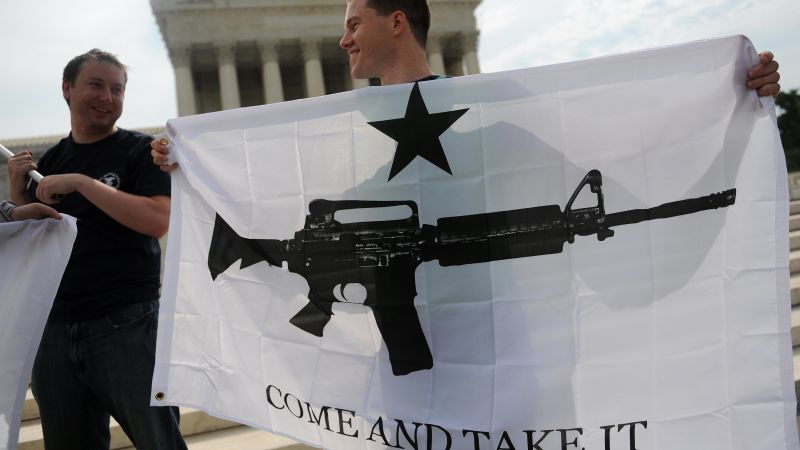
Justice Clarence Thomas opened the floodgates for all sorts of gun safety laws to be challenged in federal court.
The 6-3 Supreme Court decision striking down a type of gun carry restriction embraced by only six states, will have the effect of making all sorts of regulations all across the country vulnerable to new legal challenges.
Thomas changed the test courts are to use when analyzing the constitutionality of such regulations. Only firearm regulations that are “consistent with this Nation’s historical tradition” comply with Second Amendment’s protections, he wrote, in an assertion that puts in jeopardy any restriction that does not have a historical parallel to the nation’s founding.
This new standard will change the legal playing field around gun laws.
There are cases already in motion where courts will now adjust their approach and raise the threshold that governments will have to overcome in defending their gun safety laws. The ruling will also likely prompt a bevy of new legal challenges, with gun rights proponents now able to push more aggressive arguments for why a restriction should be struck down.
Up for grabs is not just public carry laws like the New York regime before the court. Virtually any other type of gun regulation, including age-based regulations, restrictions on certain types of firearms and limits on high-capacity magazines, will now be viewed by courts in a harsher light.
The old test versus the new test
In the fallout of a case called District of Columbia v Heller – a landmark 2008 ruling where the Supreme Court established that the Second Amendment protect an individual’s right to bear arms – appeals courts across the country had coalesced around a two-step legal approach for analyzing the constitutionality of a gun regulation.
Lower courts have looked at, first, whether the regulated activity falls within the scope of conduct protected by the Second Amendment. If it did, then they assessed whether the regulation’s means justified its ends.
“Despite the popularity of this two-step approach, it is one step too many,” Thomas wrote Thursday, calling the second step inconsistent with the Supreme Court’s previous gun rights precedents.
“Instead, the government must affirmatively prove that its firearms regulation is part of the historical tradition that delimits the outer bounds of the right to keep and bear arms,” Thomas said.
Courts are required to “assess whether modern firearms regulations are consistent with the Second Amendment’s text and historical understanding,” Thomas said.
For instance, he wrote, if a gun law is addressing a societal problem that also existed in the 18th century, it is evidence that the modern law is unconstitutional if there was no similar regulation then. Likewise, he said, if that societal problem was historically addressed using a type of regulation different than the one now before a court, that is also evidence that the modern law is unconstitutional.
“When confronting such present-day firearm regulations, this historical inquiry that courts must conduct will often involve reasoning by analogy—a commonplace task for any lawyer or judge. Like all analogical reasoning, determining whether a historical regulation is a proper analogue for a distinctly modern firearm regulation requires a determination of whether the two regulations are ‘relevantly similar,’” Thomas wrote.
What the ruling puts in jeopardy
Thursday’s ruling means that for a court to find any type of gun law constitutional, it will have to be consistent with how firearms were regulated historically.
That means states and localities will run into legal trouble whenever they try to enact a gun law that does not have a historical parallel, particularly if the problem the law is trying to address a problem that arguably has existed for generations.
This analysis will apply to the gun law cases that have already been appealed to the Supreme Court, which include challenges to California’s ban on magazines holding more than 10 rounds, Maryland’s ban on assault weapons, and a challenge to federal bump stock ban put in place by the Bureau of Alcohol, Tobacco, Firearms, and Explosives under former President Donald Trump. The high court may opt to take up those cases, or it might send them back down to lower courts with instructions that the laws are reexamined under Thursday’s ruling.
The New York decision will also likely affect what happens next in a California case, where the state’s prohibition on keeping people under the age of 21 from purchasing certain semi-automatic weapons was struck down by a conservative-leaning 9th Circuit panel.
It also may have implications for the federal gun safety package Congress is poised to pass, if and when those modest gun safety measures are challenged in court.
And a whole host of long-existing laws might be confronted with new lawsuits bolstered by the conservative justices’ new, less generous test. The New York law had been in place for more than 100 years before the Supreme Court struck it down.
Restrictions on ‘sensitive places’
Thomas’ opinion touched on how courts might view one type of restriction: restrictions on bringing firearms into sensitive places, as defenders of New York’s law pointed to that as a concern motivating its limits on public carry.
“Although the historical record yields relatively few 18th- and 19th-century ‘sensitive places’ where weapons were altogether prohibited – e.g., legislative assemblies, polling places, and courthouses – we are also aware of no disputes regarding the lawfulness of such prohibitions,” Thomas said. “We therefore can assume it settled that these locations were ‘sensitive places’ where arms carrying could be prohibited consistent with the Second Amendment.
But regulations for “sensitive places” that reached beyond those historical parallels might be constitutionally problematic, Thomas’ opinion suggested.
“It is true that people sometimes congregate in ‘sensitive places,’ and it is likewise true that law enforcement professionals are usually presumptively available in those locations,” Thomas said. “But expanding the category of ‘sensitive places’ simply to all places of public congregation that are not isolated from law enforcement defines the category of ‘sensitive places’ far too broadly.”
Thomas’ opinion also declined to resolve a “scholarly debate” over whether, when analyzing the historical context around modern gun laws, courts should be looking at 1791, the birthdate of the Second Amendment, or 1868, when the 14th Amendment was ratified. In a solo concurrence, Justice Amy Coney Barrett put her thumb on the scale for the earlier date, asserting that Thursday’s “decision should not be understood to endorse freewheeling reliance on historical practice from the mid-to-late 19th century to establish the original meaning of the Bill of Rights.”
Liberals say new test will let judges to “cloak” policy preference in “history.”
Justice Stephen Breyer, in a dissent joined by the other liberals, said the “history-only approach” is both legally flawed and ripe with “practical problems.”
“Laws addressing repeating crossbows, launcegays, dirks, dagges, skeines, stilladers, and other ancient weapons will be of little help to courts confronting modern problems,” Breyer wrote. “And as technological progress pushes our society ever further beyond the bounds of the Framers’ imaginations, attempts at ‘analogical reasoning’ will become increasingly tortured. In short, a standard that relies solely on history is unjustifiable and unworkable.”
Breyer called Thomas’ opinion “deeply impractical.”
“It imposes a task on the lower courts that judges cannot easily accomplish,” Breyer wrote.
“The Court’s insistence that judges and lawyers rely nearly exclusively on history to interpret the Second Amendment thus raises a host of troubling questions,” Breyer added, pointing to the research resources such an approach requires, how judges will choose which historians to rely on, and what courts are to make of new developments in historical research.
“And, most importantly, will the Court’s approach permit judges to reach the outcomes they prefer and then cloak those outcomes in the language of history?” Breyer wrote.
The majority, he added, gives judges license to reject certain evidence in a way that will allow them “to pick their friends out of history’s crowd.”
He said that, at the time of the nation’s founding, even the country’s largest cities, like New York, had very small populations compared to today, while the vast majority of Americans lived on farms or in small towns.
Addressing Thomas’ examples of historically consistent “sensitive places,” Breyer asked what that meant for “subways, nightclubs, movie theaters, and sports stadiums?”
“The Court does not say,” Breyer wrote.
RSS




